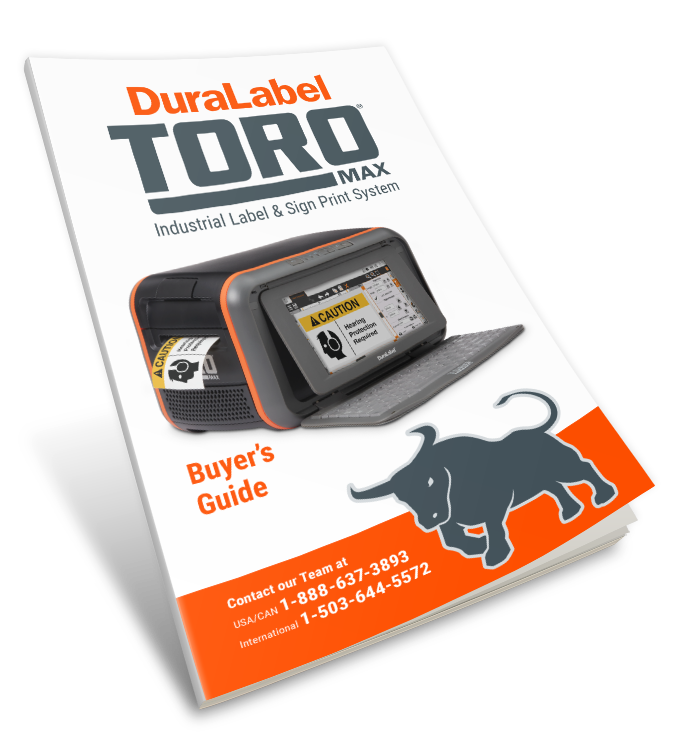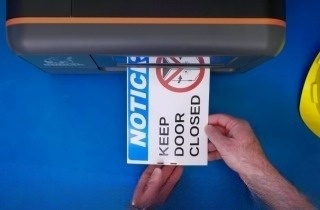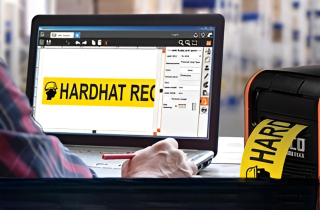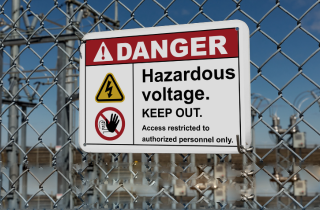How DuraLabel Systems Improve GHS Labels for Compliance and Safety

How DuraLabel Printers Simplify GHS Labeling for Compliance and Safety
In regulated industrial environments, accurate chemical labeling is essential to both worker safety and regulatory compliance. The Globally Harmonized System of Classification and Labeling of Chemicals (GHS)—enforced in the United States under the Occupational Safety and Health Administration (OSHA) Hazard Communication Standard (29 CFR 1910.1200)—requires clear, standardized labeling to communicate chemical hazards across all workplaces.
DuraLabel Industrial Sign and Label Systems simplify this process by providing preloaded templates, intuitive design software, and durable materials that streamline the creation of compliant labels. With the ability to produce fully GHS compliant chemical labels on-site and on demand, DuraLabel systems help organizations reduce labeling errors, maintain consistency with safety data sheets, and ensure hazard communication remains clear and reliable in any environment.
Who Needs GHS-Compliant Labels?
Any workplace that handles hazardous chemicals—whether in storage, transport, or use—must follow GHS labeling protocols. These requirements apply across a range of industries, including:
- Chemical manufacturing and distribution
- Oil and gas
- Utilities and construction
- Food and beverage production
- Pharmaceuticals and life sciences
- Warehousing and logistics
- Research institutions and laboratories
- Maintenance and repair departments
These environments rely on accurate, durable, and GHS compliant chemical labels to protect workers, pass inspections, and avoid costly violations.
What Information Must GHS Labels Include?
According to OSHA and GHS standards, GHS compliant chemical labels must feature the following elements:
-
Product Identifier: The name or code for the chemical, consistent with the SDS.
-
Signal Word: Either “Danger” or “Warning”, depending on the severity of the hazard.
-
Hazard Statements: Standardized phrases describing the chemical’s risks.
-
Precautionary Statements: Instructions for safe handling, storage, and response.
-
Pictograms: One or more symbols enclosed in red diamonds to indicate the nature of the hazard.
-
Supplier Information: Name, address, and contact number of the manufacturer or distributor.
Each label must be legible, durable, and formatted in accordance with GHS design requirements. In addition, label content must match the product’s safety data sheet for hazard communication to ensure regulatory compliance and consistency. The use of properly formatted GHS labels helps ensure that hazard information is visible and understood at a glance.
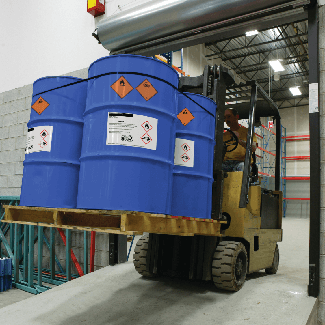
Challenges with Manual GHS Labeling
Many organizations attempt to meet labeling requirements using spreadsheets, desktop printers, or repurposed office tools. While workable in theory, these methods often lead to:
-
Inconsistent layouts that confuse workers or violate formatting rules
-
Human error during manual data entry from SDS documents
-
Increased rework due to fading, peeling, or damaged labels
-
Slow production that delays chemical handling or shipment
-
Regulatory risk from incorrect or missing label elements
These challenges can be especially problematic in high-volume or fast-paced environments where compliance must be balanced with efficiency. Manually producing GHS labels often leads to inconsistent results and unnecessary risk.
Streamlining GHS Labeling with DuraLabel Toro Max
The DuraLabel Toro Max Industrial Sign and Label System is a portable, all-in-one labeling system designed to simplify regulatory compliance while improving labeling speed and consistency. Combined with the free LabelForge PRO Design Software, it offers a complete solution for generating compliant GHS labels in-house.
Built for OSHA 1910.1200 and GHS Standards
Toro Max includes preloaded label templates that meet the formatting and content requirements outlined in OSHA’s Hazard Communication Standard. Pictograms, signal words, and required phrases are incorporated into every design, removing the guesswork from GHS labeling.
Seamless Integration with Safety Data Sheets
LabelForge PRO software enables teams to input label content directly from safety data sheets for hazard communication. This eliminates repetitive typing and reduces the risk of missing or mismatched information.
Database and Template Management
Users can save, categorize, and retrieve label templates across a wide range of substances and departments. This centralized label management supports consistency and helps streamline updates when regulations or SDS details change. When printing GHS compliant chemical labels, consistency is key to both safety and audit readiness.
Industrial-Grade Durability
The Toro Max prints on materials that resist exposure to:
-
Harsh chemicals
-
High humidity or direct water contact
-
UV radiation and sunlight
-
Extreme temperatures
GHS labels remain intact and legible in demanding environments, helping businesses maintain compliance and visibility over time.
On-Site Printing for Fast, Flexible Labeling
With its built-in touchscreen and rechargeable power supply, the Toro Max enables mobile printing wherever GHS labels are needed. Teams can produce accurate, high-quality labels without returning to a central print station.
Why Label Durability Matters in Hazard Communication
In industrial environments, label durability is essential for effective hazard communication. Exposure to moisture, chemicals, UV light, and abrasive conditions can quickly degrade labels printed on standard materials. If critical information fades, peels, or becomes illegible, the result can be confusion, mishandling, or even regulatory violations.
GHS labels are not just for visibility—they serve as a lasting reference for identifying hazards and guiding safe handling. OSHA’s Hazard Communication Standard expects this information to remain accessible for as long as the chemical is present in the workplace.
To meet these expectations, facilities must select printing systems and label materials designed for harsh conditions. Durable GHS compliant chemical labels must resist smearing, tearing, and weathering, ensuring that safety messages remain intact over time. Whether used in a processing plant, warehouse, lab, or outdoor site, high-quality labels play a vital role in long-term compliance and risk reduction.
Manual GHS Labeling vs. DuraLabel Toro Max Printer
| Manual Process | DuraLabel Toro Max Printer |
| Basic office printers or spreadsheets | Preloaded GHS-compliant templates |
| Manual data entry from SDS | Uses SDS data to auto-fill label content |
| Short label lifespan | Long-lasting, industrial-grade materials |
| Format inconsistencies | Standardized layouts and pictogram placement |
| Centralized printing only | Portable, on-site labeling capability |
DuraLabel GHS Labeling Resources
Hazard communication is not a one-time compliance exercise—it is a continuous system of communication, preparation, and safety reinforcement. Aligning with GHS, maintaining up-to-date training, and using dependable labeling systems all contribute to a safer, more compliant workplace.
For facilities managing hazardous chemicals, the quality of labeling tools directly impacts the clarity and reliability of risk communication. Industrial label printers like the DuraLabel Toro Max Industrial Sign and Label System, combined with robust software like LabelForge PRO, help ensure that every GHS label meets regulatory standards without disrupting productivity. Together, they provide the consistency and durability required in high-demand industrial settings.
To assist organizations in evaluating or refining their approach, the GHS/HazCom Labeling Quick Start Guide is available as a free resource. This guide outlines OSHA and GHS requirements, includes examples of compliant labels, and offers practical guidance for selecting materials and implementing a compliant labeling process.
Whether updating an existing program or developing one from the ground up, this guide can serve as a reference for maintaining long-term compliance and safety.
For additional support or specific questions, DuraLabel’s team of safety and compliance specialists is available at 1-888-788-9855. They can provide expert recommendations tailored to a facility’s unique hazards and labeling needs.
Read Next:
Why Upgrade to the DuraLabel Toro Max Industrial Print & Label System
DuraLabel’s Tough-Tested Process: Raising the Bar for Label Durability
Related Resources

What is HazCom? Your Guide to Chemical Labeling, GHS, & OSHA Standards
What Is OSHA’s Hazard Communication Standard (HazCom)? "HazCom" is short for "Hazard Communication," OSHA’s ...
Read
Hazard Communication Solutions for a Safer Workplace
A faded label. A missing hazard symbol. An outdated SDS. These small details can trigger big problems in ...
Read
GHS Label Information
Appendix C to the 2012 (OSHA 1910.1200) Hazard Communication Standard (HCS) specifies the mandatory ...
Read.png)
